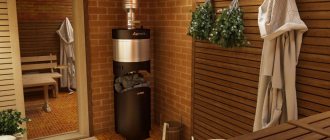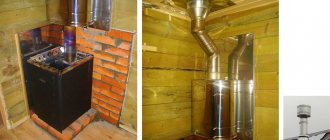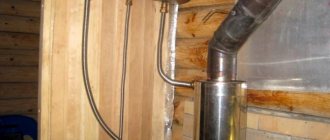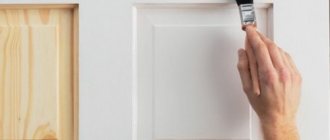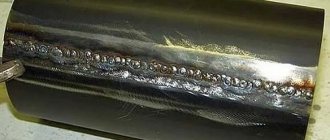A metal stove is good for everyone; it quickly heats the room, and there are fewer problems with installing a steel or cast iron firebox than with a brick one. The only thing you need to pay attention to is the protective coating of the metal. Correctly painting an iron stove in a bathhouse is not difficult, but you need to choose the right paint and not engage in amateur activities in the process of applying the paintwork.
For heat-resistant paint, the viscosity does not change with increasing temperature, but there is an odor, so it is better to paint metal parts outside the bathhouse
Factors that have a negative effect on paint
According to experts, it can reach +600°C in the furnace due to fuel combustion. The steel becomes red hot. Periodic heating and cooling has a detrimental effect on strength indicators. A metal stove in a Russian bath is simultaneously exposed to high humidity and heat; the walls begin to rust inside and out. In a sauna the air is drier, but the air temperature is also higher.
Carbon monoxide can leak into the bathhouse through burnt walls; using an unprotected stove is dangerous to life.
Periodic heating and cooling has a detrimental effect on strength indicators.
How to paint a metal stove?
The process of painting a metal stove is similar to similar work with other materials. Before starting work, make sure the quality of the paint - check the expiration date, the absence of lumps, additional impurities, etc. Mix the paint thoroughly, making movements not only in a circle, but also kneading the paint from the bottom.
It is necessary to paint a metal stove in an even, uniform layer. Pay attention to corners and seams, as these are the places where untreated surfaces most often remain. If you do not want to stain the surrounding area of the oven, then use cellophane and masking tape.
- You can use a brush to paint the stove.
- A can of spray paint is perfect for fittings.
What tasks does paint perform?
A layer of paint for a metal sauna stove performs two functions at once: it increases the practicality of the sauna and improves the appearance of the dressing room and steam room. Heat-resistant coatings are resistant to thermal shock and have water-repellent properties.
By the way, welded structures with a tank for water and a firebox are sold in painted or unpainted form. The second option is painted before installation so that the steel does not have time to burn.
A layer of paint for a metal sauna stove performs two functions at once: it increases the practicality of the sauna and improves the appearance of the dressing room and steam room.
Choosing paint for the stove
The operating temperature for standard metal paint does not exceed 40-50 ℃, so you cannot paint surfaces that are too hot - it will bubble up, lose its original color and may begin to smoke and smell unpleasant. Therefore, in this case, you need to use only special heat-resistant paint for stoves.
Which of the proposed paint options to choose will depend on the area of its application. Thus, a metal sauna stove can heat up to 600-800 ℃ or more - at the epicenter of combustion the temperature is even higher. But its outer walls may not heat up so much - it all depends on the design. Therefore, you need to know how to properly install a stove in a bathhouse. If we are talking about a brick oven, then its surface does not warm up above 200 ℃.
Please note that heat-resistant paint must be suitable for interior use. And for sauna stoves you need paint with moisture protection.
Do I need to paint or is there an alternative?
It is recommended to paint the metal before laying the heat-resistant brick screen and cover the inside of the tank. Instead of painting, bluing is used (details below) or other methods are used:
- Eco-friendly surface treatment with silver is quite effective;
- A budget option is red lead, used in metallurgy;
- A heat-resistant mixture of lime and cement provides good protection against oxidation.
It is recommended to paint the metal before laying the heat-resistant brick screen and cover the inside of the tank.
Choosing between paint and varnish
The brick surface of fireplaces and stoves can be treated with paint or varnish. Both options have pros and cons.
Often brickwork has an attractive appearance that fits perfectly into the interior of the room. However, temperature changes, physical impact, and in baths - contact with steam, lead to damage to the top layer. Varnish is able to protect the masonry, leaving its pattern unchanged.
The surface treated with varnish takes on a “wet” tint. Therefore, the pale red color of the brick will become more reddish, and the white grout will become gray.
The varnish can be applied to the entire surface at once. This allows you to get the job done quickly and easily. When painting, if you use enamel and you need to preserve the masonry pattern, you will have to use a stencil and cover the grout, which is extra time and extra effort.
In addition, the varnish immediately helps to cover not only the brick, but also the masonry joints. This prevents the grout from crumbling due to thermal expansion. If enamel is used for painting, then you need to secure the seams between the bricks with a high-temperature sealant.
In the case when the surface pattern is not important, then paint, as well as varnish, can be applied in a continuous layer to both the brick and the grout. Black enamels are often used for baths, as they are most common in stores.
When painting a stove located in a bathhouse or sauna, it is necessary that the composition, after drying, can withstand the high humidity characteristic of rooms of this type.
The following article will introduce you to guidelines for choosing paint for restoring the external coating of radiators, which we strongly recommend reading.
Characteristics
Before painting a stove in a bathhouse, you should take into account a number of criteria by which paint and varnish materials are selected. There are several of them, each is important in its own way and affects the strength of coatings under the influence of “bath hazards”.
Before painting a stove in a bathhouse, you should take into account a number of criteria by which paint and varnish materials are selected.
Heat resistance
This indicator is indicated on the label in degrees. Manufacturers inform about the maximum heating at which the properties of the film formed after the coloring composition has dried are preserved.
Manufacturers inform about the maximum heating at which the properties of the film are preserved.
Corrosion protection
To prevent the metal from rusting, it is necessary to isolate the alloy from oxygen. Hydrogen increases the brittleness of metals, and nitrogen at high temperatures also has a negative effect on steel.
To prevent the metal from rusting, it is necessary to isolate the alloy from oxygen.
Water repellent properties
Choose paint coatings that repel moisture. This is necessary to prevent oxidation and cracking during the winter.
Choose paint coatings that repel moisture.
Safety
When heated, organic compounds release volatile hydrocarbons; such paints and varnishes can cause poisoning. The bath requires harmless, non-toxic paints and varnishes.
When purchasing paints and varnishes, the choice is made in favor of branded, time-tested products.
The bath requires harmless, non-toxic paints and varnishes.
How to choose the right one
To choose the right paint for the stove, you need to carefully consider the label, which says what surface it can be used for, for example, heat-resistant paint for metal products. Often this information is printed in large font and is difficult to miss. In cases where the scope of application of paint and varnish products is wide, this is also written on the packaging, but in small print. Be that as it may, such information must be indicated on the packaging, as well as the name of the manufacturer. If this data is not available, there is no need to purchase such a product. It is possible that this is a counterfeit product that may pose a threat to your health.
For metal sauna stoves, use only moisture-resistant compounds, otherwise they will not last long on the surface.
Kinds
Heat-resistant paint for sauna stoves is produced in a large assortment. Paint and varnish mixtures are classified according to their basic components:
- Organosilicon coatings form a glass film that retains strength at +800°C, have good adhesion to metal, and are not afraid of water;
- Polyurethane is wear-resistant, can withstand heating up to +600°C, and is often used for boiler equipment. Minus - some compositions change color due to thermal exposure;
- Water-based ones with acrylic filler are more suitable for saunas or painting the stove on the side of the dressing room, where there is no high humidity.
According to user reviews, several heat-resistant coatings deserve attention:
- “Hammerite”, “ELCON” - enamels with corrosion inhibitors;
- “Kudo” enamels with silicon;
- “Hansa” in aerosol cans or cans is produced in about 16 shades;
- Gray or black “Tikkurila” with alkyd resin;
- "Bosni" is a universal composition for many types of surfaces.
For reference. For thin-walled fireboxes, it is recommended to choose coatings with a heat resistance rating of +800...850°C.
Water-based ones with acrylic filler are more suitable for saunas or painting the stove on the side of the dressing room, where there is no high humidity.
Preparing the oven surface for painting
The process of preparing the stove for painting is simple and straightforward, but it must be carried out in full, otherwise the consequences will be dire. It is important that pure metal remains under the paint layer without any additional impurities.
The process looks like this:
- Thoroughly clean the surface with a wire brush.
- Remove remaining oxides with a solution of sulfuric acid with a concentration of 5%.
- Wash off the acid with a mixture of laundry soap.
- Degrease the metal surface using any available method - usually a solvent.
- Paint the surface with paint.
There is nothing complicated in the process itself, but you should pay attention to the details, since this is where mistakes are made. This process may not seem like a big deal, but if you don't do it, the paint will start to fall off soon enough!
Is it possible to coat equipment with enamel?
Among the large number of paints for a hot water tank in a bathhouse, it is better to choose special enamels marked “KO 8” from leading manufacturers. This means that silicone enamel can withstand high temperatures. Conventional enamels for metal quickly become painted due to temperature changes.
Silicone enamel can withstand high temperatures.
Which paint is best?
As mentioned earlier, the wide variety of paints allows customers to choose from several alternatives. You should take into account operating conditions, environmental properties (humidity, dust levels, etc.), as well as your financial capabilities. It is better to use expensive silicone paint, but for many it is still too expensive.
For iron
Iron furnaces are quite susceptible to degradation and oxidation, since the molecular structure predisposes the material to react with oxygen. High temperature also quite actively accelerates this process, which shortens the service life of the furnace.
If you want the stove to serve for many years, then you should use silicone paint from various manufacturers.
One of the leaders in the domestic market is Elcon, which has modern production. This manufacturer belongs to the “budget” class, but its quality is sufficient for domestic use.
It is important to carefully follow the painting technology, since otherwise the paint will not be able to protect against destructive factors. Remember that painting is not a universal solution that is guaranteed to protect the metal - it is important to follow the painting technology!
For cast iron
Cast iron is a fairly strong metal alloy that can withstand prolonged exposure to extremely high temperatures. Some sources report that you can avoid dyeing altogether, but it’s better to be on the safe side.
An excellent option for a cast iron stove is water-based acrylic or polyurethane paint, which has proven itself to be excellent. Moreover, the cast iron alloy tolerates even violations of the painting technology more favorably, so you don’t have to worry about making quite serious mistakes.
Coating instructions
When painting stoves yourself, it is important to follow the sequence of operations and adhere to the technology, then the bathhouse will be protected.
When painting stoves yourself, it is important to follow the sequence of operations and adhere to the technology.
Tools and materials
In addition to paintwork materials and brushes, you will need sandpaper or a metal brush to remove rust, and a solvent to degrease steel. It is necessary to cover the floor and wall so that there are no smudges.
In addition to paintwork materials and brushes, you will need sandpaper or a metal brush to remove rust, and a solvent to degrease steel.
Surface preparation
The metal is pre-cleaned to a metallic shine. After removing dust, wipe the surface with a solvent.
Stainless steel fittings and adapters are coated with grease to protect them from staining.
The metal is pre-cleaned to a metallic shine.
Work algorithm
Mix the paint before use, start painting from hard-to-reach places, then cover the remaining areas. Coatings are applied in one layer, unless otherwise specified by the manufacturer.
The paint is mixed before use.
How long does it take for the coating to dry and after what time can it be heated?
It is better to wait 5 days after painting, only then start lighting the stove. Paint for a metal stove in a bathhouse dries on average from 72 to 96 hours, depending on the plasticizer.
Some coatings dry only when heated; the stove is lit, but not allowed to become very hot. For safety, open the window and door.
It is better to wait 5 days after painting, only then start lighting the stove.
A little about the types of heat-resistant paints
Painting very hot surfaces of metal furnaces can only be done with heat-resistant, heat-resistant and fire-resistant paints. But fire retardants are not suitable in this case - they are used for other purposes. When heated to 200 ℃, fire-retardant paint swells and blocks the access of oxygen to the structure, protecting it from destruction in fire. Let's take a closer look at the types of paints.
So, heat-resistant paint for stoves is used at a temperature threshold of 600 ℃. Such compositions are suitable for painting metal elements of stoves and fireplaces, as well as for metal heating appliances. But for sauna stoves they use several different types of materials - heat-resistant enamel, which is designed to heat the surface to 800-1000 ℃.
Fireproof paint for metal products can withstand exposure to open flames. Therefore, its temperature threshold is even higher. However, due to the very high cost, it is not advisable to use such compositions at home.
Another type of paint is high-temperature. Their area of application is painting heating batteries and a number of engine components. As a rule, such compositions are operated under heating conditions no higher than 200 ℃. High-temperature paint for brick stoves can only be used if it is necessary to tint the surface or paint the seams. Metal stoves cannot be painted with it.
For brick stoves, you can also use heat-resistant varnish. Its operating temperature is 250-300℃. After treating the surface with this varnish, it becomes shiny and brighter.
Burnishing an iron stove
Blueing is the etching of metal with phosphoric acid, which creates a protective layer of phosphates on the steel. A similar technology is applicable in baths. The cleaned, degreased metal surface is treated with a solution of phosphoric acid. Add 150 ml of acid and 4 g of butyl alcohol per liter of water. After the solution has dried, the metal is washed with laundry soap. Then the surface is heated to 150 C, and a 10% solution of caustic soda is applied to them using a spray gun.
Blueing is the etching of metal with phosphoric acid, which creates a protective layer of phosphates on the steel.
If desired, the metal stove and tank can be made into decorative parts of the bathhouse interior. For painting, it is better to choose heat-resistant enamels, which are durable and decorative. There will be no rust with this coating.
Decorating with patina
12 hours after applying the base layer, apply a heat-resistant patina to give a decorative effect. There are several patination techniques. The most popular is the so-called “dry brush”. Mix Patina thoroughly before use. Dip a flat brush into the paint. Rub the excess on the palette. With light movements we go over the most protruding areas of the oven, without completely covering the previous staining. After applying the patina, allow it to dry completely for a day.
Why don't we use regular paints?
Paints for barbecues and other heated surfaces must have certain properties that conventional paint compositions simply do not have. That is why heat-resistant paint is necessary for painting stoves, radiators, barbecues and other surfaces.
Grill paint
Painting with conventional paints is not allowed for a number of reasons, which we will consider further:
- The color of the coloring pigment will definitely change due to the increase in temperature. Any coating may simply turn yellow or blacken
- The coating will crack, and its complete or partial peeling is also possible.
- The binder base will be lost, and the paint layer will be charred and completely destroyed
